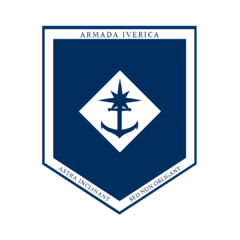Iverican Naval Aviation Service
This article is incomplete because it is pending further input from participants, or it is a work-in-progress by one author. Please comment on this article's talk page to share your input, comments and questions. Note: To contribute to this article, you may need to seek help from the author(s) of this page. |
| Naval Aviation Service of Iverica | |
|---|---|
| Armada Servicio L'Aire | |
 | |
| Active | 1920 |
| Country | Republic of Iverica |
| Branch | Armada Iverica |
| Type | Naval Aviation |
| Role | Aerial Warfare |
| Size | 8,100 Regular Personnel 2,000 Irregular Reserves |
| Garrison/HQ | Manille Comande Marítima |
| Patron | St. Erasmo |
| Motto(s) | Non Solis radios sed Iovis fulmina mitto(Aroman)
"Send not the rays of the Sun but the lightning-bolts of Jupiter" |
| Mascot(s) | Osprey |
| Commanders | |
| Capo-Almirante dei Armada | CAA Francisco Mondragón |
| Capo-Audante dei Armada | Giulius Adorno |
The Naval Aviation Service or Armada Servicio L'Aire (ASA) is a subdivision of the Iverican Navy created with the purpose of training, maintaining, operating, and advancing aero-naval equipment. Their primary role is to provide the Navy and Marine Tercios with effective aero-naval warfare capabilities. Their missions vary from anti-ship missions, anti-submarine missions, carrier-based combat air patrol, AEW&C, SEAD, ground strike, close air support, to name a few. All Air Service aircraft bear the distinctive navy flash, roundel, and lettering "AAR" (Armada Aero dei L'Republica, "Naval Aircraft of the Republic"). The Air Service's motto is Non Solis radios sed Iovis fulmina mitto, which in translates in Anglish to, "Send not the rays of the Sun but the lightning-bolts of Jupiter".
Doctrine
As a result of the higher responsibility and larger budget allocation, the Navy and its Air Service have been expected to maintain a technical superiority with aircraft and aerial equipment. Using experience from the three major naval theatres Iverica has engaged in during the 20th century, the Navy has formed its aeronaval doctrine on the basis of its technological and qualitative advantages. Offensively, the Air Service is competent at conducting Suppression of Enemy Air Defence operations with an approach of Effects-Based Operations. This involves the use of several airframe types, often simultaneously. Some of these include swing-role fixed-wing and rotor aircraft in both air superiority and strike roles, unmanned air vehicles in reconnaissance and forward decoy roles, electronic warfare aircraft to protect the sortie, and AEW&C aircraft for intelligence, command & control within the area of operation. Defensively, the Air Service relies on air patrols and strike missions, typically originating from a carrier or coastal airfield. Within the area of the Iverican Peninsula, sorties can rely on the peninsula's Integrated Air Defence System, sea-based units mounting radar, or ground-based radar vehicles for early warning and command & control. In further waters, the Navy relies on coordination between the surface formations and AEW&C aircraft for intelligence. This focus on signals intelligence gives patrolling flights or strike sorties a higher probability of detecting, and thus, firing radar-guided ordnance first.
Organisation
The Air Service has no distinct command or rank structure that differs from the rest of the Navy. For all intents and purposes, the Air Service is just a unique subdivision that has a different training curriculum and standard. The overall command is still overseen by the Naval High Command known as Encícomando D'Armada in Iverican.
In terms of unit formations, the Air Service still uses terms such as Group and Squadron but has an additional unit classification of "Detachment" (Iverican: Detacemente) which typically refers to any group of aircraft stationed on a carrier vessel or deployed to suit specific operation orders of battle.
Budget
An estimated $7.5 billion standard units are allocated to the Air Service from the annual naval budget (RAS-2020). The Armada as a whole is responsible for deployment expediatures, research & development, and procurement of equipment for its sub-branches as such, the Air Service Budget is mainly for the upkeep of personnel and existing equipment. Per capita, the Navy spends up to three times more than the Iverican Air Force does. This imbalance in the allocation is owed largely to the different doctrines and deployability of both air warfare groups. Compared to the air force, the naval Air Service is expected to conduct offensive and preemptive operations against foreign threats. While the air force exists as a peninsula-based defensive force, the Air Service supports amphibious landings and provides aerospace coverage over a much wider area of responsibility.
Personnel
The ASA currently employs 8,100 dedicated personnel. Among this number are pilots, aircraft mechanics, aircraft engineers, and other types of aircrew. For labour-intensive roles, administrative roles, signal roles, and other ground roles, the Air Service depends on staffing by the rest of the Navy. Effectively, the Air Service and the rest of the Navy are one and the same, as the service is an inextricable part of the naval warfare branch.

